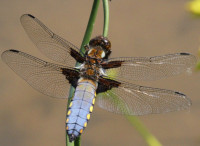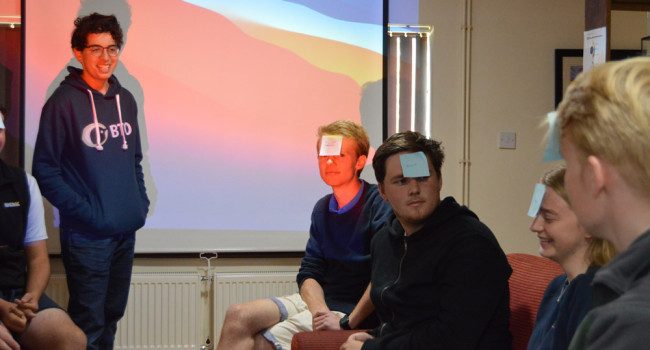
How and why to record dragonflies in August
Many dragonflies and damselflies are on the wing at this time of year. BTO’s Rob Jaques writes about watching, recording, and supporting these beautiful insects.
Robert began working at BTO in 2018 on Garden BirdWatch (GBW), where he now regularly contributes to Bird Table magazine, reviews quarterly GBW data, and manages the GBW Ambassador programme as part of his responsibilities.
Relates to projects
August is a notoriously quiet month for birdwatching. While there are birds to watch at all times of year, many birds are done with breeding by late summer, and we haven’t quite reached the peak of autumn migration yet. This is often a time, therefore, when birders will cast their eyes over different taxa, and dragonflies (and damselflies) fill the demand nicely - watching hawkers and emperors hunt on the wing can be as exciting as seeing stooping Peregrines or swirling flocks of waders.
Dragon or Damsel?
Dragonflies and damselflies are the aerial acrobats of the insect world, but do you know how to tell them apart?
Learn more about the identification and lifecycles of these creatures in our Garden BirdWatch article.
Discover DragonfliesGarden BirdWatch has been taking dragonfly records since 2011, so we are able to see which species make use of our gardens and, with enough records, how populations have changed over time.
The most common garden species are the Large Red Damselfly and the Southern Hawker.
The most common garden species are, perhaps unsurprisingly, the most adaptable and those that are most comfortable with small bodies of water. The most often-recorded species in gardens is the Large Red Damselfly, an incredibly adaptable species, and tolerant of relatively poor-quality waterbodies. They also emerge early in the season, sometimes as soon as April, meaning they are easily noticed and identifiable.
The second most recorded species is the Southern Hawker. In wild settings, these are most often seen hunting in woodland clearings, sometimes quite far from obvious water sources. Our gardens can easily replicate this habitat, especially those with mature trees and hedgerows.

Dragonflies and damselflies as indicators of the wider environment
Dragonflies and droughts
With drought conditions across the UK, aquatic species are on our minds. Adult dragonflies can cope in hot, dry conditions, as they are still able to hunt their insect prey, but nymphs (immature dragonflies) and eggs need water to survive. We're not yet sure what impact the droughts will have on dragonfly populations, but by taking part in Garden BirdWatch you will give us valuable information about how garden species may be affected.
Join Garden BirdWatch todayIf you have a garden, it is easy to help dragonflies by making a mini-pond. An old sink, plastic barrel or tiny amount of pond lining, fitted with some pond plants, can quickly become a dragonfly hotspot. Keep the water topped up all year round, and you might see results straight away. Many species are quick to find new water bodies, and if they lay eggs, the next generation could emerge from your pond the following year.
How to make a mini-pondThese are interesting times for those interested in recording dragonflies. Some species are renowned for their long-distance journeys, opening the possibility for unusual species to appear in the UK. In recent years Lesser and Vagrant Emperors, species more common in southern Europe, have become more regular visitors to British shores. Other species have moved in and begun to breed, such as Willow Emerald Damselflies. These were first recorded in the early 2000s and have now colonised most of eastern England. Similarly, Southern Migrant Hawkers first showed up around the Thames estuary in 2010 and have been recorded breeding since.
While it is exciting to see our diversity of dragonflies increase, it does reveal a stark truth about our changing climate. Many of these colonising species are taking advantage of our warming waters, but this could be bad news for our northern species. Azure Hawker and Northern Damselfly prefer the cooler waters of Scotland, and as water temperatures increase alongside other threats, such as drainage and loss of habitat, they may be lost from the UK.
Records of dragonfly and damselfly sightings are also useful reflections of habitat quality. Many dragonfly and damselfly species require specific water conditions to complete their life cycles, as most will spend at least a year, if not longer, as larvae beneath the water’s surface. When these insects are present at a site, or a new population establishes, it can be an indicator of improving or high-quality water conditions. Conversely, when the conditions aren’t quite right, invertebrates are often the first to be affected, making their population changes the canary in the coal mine for environmental factors like pollution that will later have cascading impacts on other taxa, including birds.
What next?
Hopefully, if you don’t already, you will soon start to record the dragonflies and damselflies you see. This can either be a structured weekly watch through Garden BirdWatch, or a more ad hoc approach through BirdTrack. Either way (or ideally both!) will mean we can gain a better understanding of these fascinating insects, and more information about the habitats they use.
Dragonflies can be tricky to identify for those just starting out. Fortunately, Garden BirdWatch has a number of guides to help you get started with these groups. Blue damselflies in particular present a challenge - check out our guide below to help you learn the differences between the three most commonly recorded blue damselfly species.
We will also be running training sessions for identifying garden invertebrates in spring 2023; be sure to sign up for the GBW newsletter to be the first to book on to these courses!











Share this page